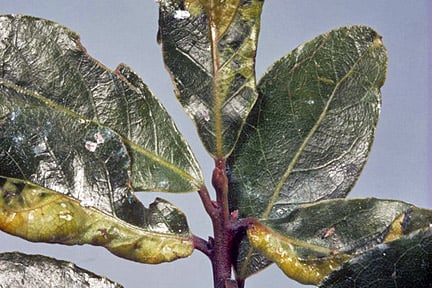
Quick facts
Common name - Bay sucker
Scientific name - Lauritrioza alacris
Plants affected - Bay (Laurus nobilis)
Main symptoms - Leaves develop curled leaf margins that are thickened and pale yellow.
Most active - May to October
What is bay sucker?
The psyllids or plant suckers are a group of sucking true bugs (Hemiptera). There are more than 40 species found in Britain. Many species produce a white waxy secretion during the immature (nymph) stages and some cause distortion and galling to host plants. Most however, do not cause any significant damage to garden plants. More information on Psyllids from in Britain can be found at .
Bay feeds on the foliage of bay during the summer, the nymphs can cause distortion to leaf edges.
Symptoms
- Bay tree leaves thicken, curl downwards at the margins and turn yellow; often only half of the leaf is affected
- The discoloured areas later dry up and become brown
- Small greyish white insects may be seen underneath or near the curled leaf margins. The nymphs usually producing a white waxy material
- The long term health of the plant is usually unaffected

Management
Bay can affect the appearance of bay but does not usually reduce the vigour of bay plants and so control is not necessary. Plant suckers can be a part the a healthy garden supports.
- Often suckers do not affect the growth or vigour of plants and so can be tolerated
- Encouraging predators and other natural enemies of suckers, in the garden, such as birds , ladybirds , wasps and ground beetles will help keep damage to a minimum
- If necessary distorted leaves can be removed from the plant however, this may cause more damage than the insect
Biology
Curled thickened bay leaves are often caused by the nymphal stages of the bay when they suck from the young leaves during the summer.
- The winged adults are greenish brown and about 2 mm long (less than 1/8 in), and they overwinter in sheltered places
- In April to May, adult bay suckers emerge and start to feed, causing the leaf margins to begin curling over. Eggs are laid under the curling leaf margins
- The nymphs are grey, flattened wingless insects, whose bodies are covered with a white fluffy material
- Like the adults, the nymphs suck sap and increase the leaf curling and discoloration
- Two or three overlapping generations occur between May and September



